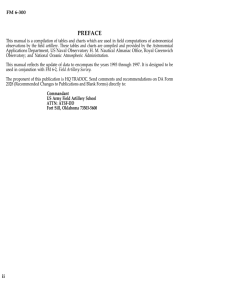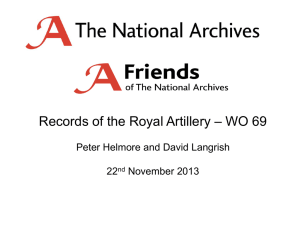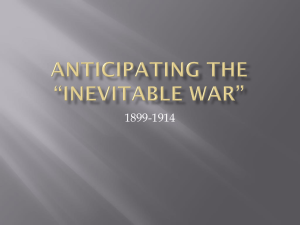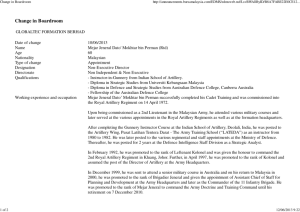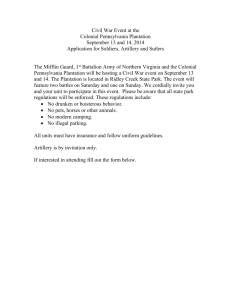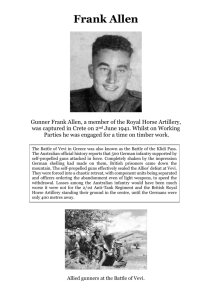Chapter 7 MCWP 3-16.1 Marine Artillery Operations Artillery Communications and Information Systems
advertisement
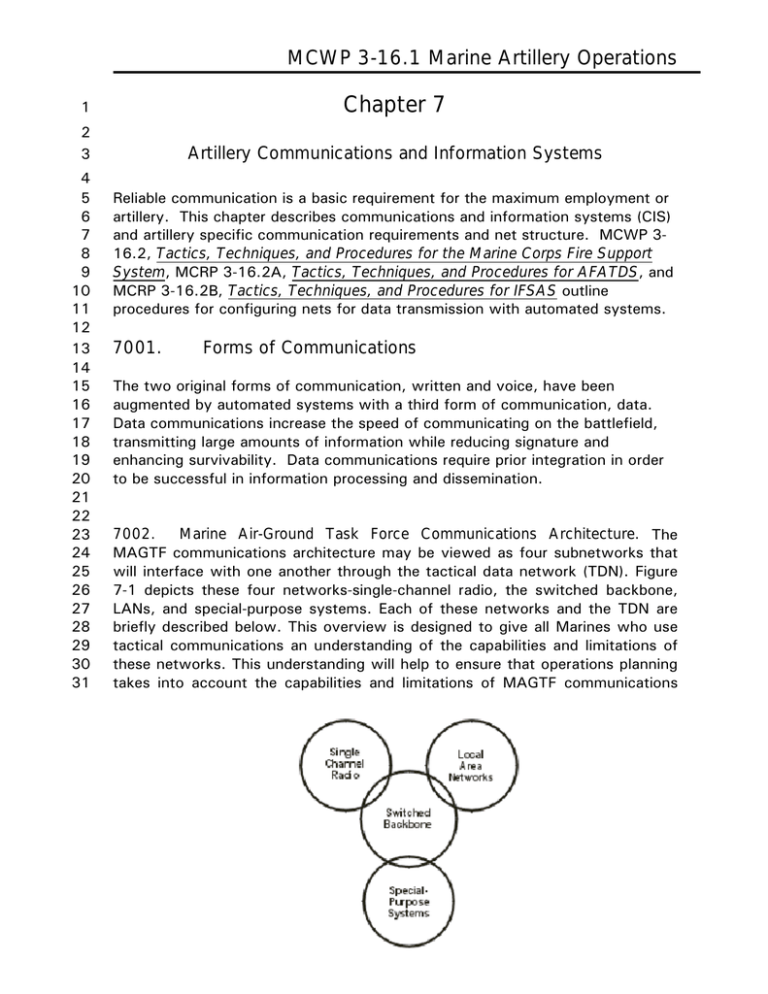
MCWP 3-16.1 Marine Artillery Operations 1 Chapter 7 2 3 Artillery Communications and Information Systems 4 5 6 7 8 9 10 11 12 13 14 15 16 17 18 19 20 21 22 23 24 25 26 27 28 29 30 31 Reliable communication is a basic requirement for the maximum employment or artillery. This chapter describes communications and information systems (CIS) and artillery specific communication requirements and net structure. MCWP 316.2, Tactics, Techniques, and Procedures for the Marine Corps Fire Support System, MCRP 3-16.2A, Tactics, Techniques, and Procedures for AFATDS, and MCRP 3-16.2B, Tactics, Techniques, and Procedures for IFSAS outline procedures for configuring nets for data transmission with automated systems. 7001. Forms of Communications The two original forms of communication, written and voice, have been augmented by automated systems with a third form of communication, data. Data communications increase the speed of communicating on the battlefield, transmitting large amounts of information while reducing signature and enhancing survivability. Data communications require prior integration in order to be successful in information processing and dissemination. 7002. Marine Air-Ground Task Force Communications Architecture. The MAGTF communications architecture may be viewed as four subnetworks that will interface with one another through the tactical data network (TDN). Figure 7-1 depicts these four networks-single-channel radio, the switched backbone, LANs, and special-purpose systems. Each of these networks and the TDN are briefly described below. This overview is designed to give all Marines who use tactical communications an understanding of the capabilities and limitations of these networks. This understanding will help to ensure that operations planning takes into account the capabilities and limitations of MAGTF communications Coordinating Draft 7 - 1 MCWP 3-16.1 Marine Artillery Operations 1 2 3 4 5 networks. For a more detailed discussion of the MAGTF communications architecture, readers should refer to chapter 4 of MCWP 6-22, Figure 6-1. Marine Air-Ground Task Force Communications Architecture 6 7 8 9 10 11 12 13 14 15 16 17 18 19 20 21 22 23 24 25 26 27 Figure 3-2. SCR (1) Single-Channel Radio. MAGTF single-channel radio equipment includes handheld, manpack, vehicle-mounted, ground-mounted, and shelterized radios operating in the HF, very high frequency (VHF), and ultrahigh frequency (UHF) bands (see figure 7-2). It also includes TACSAT radios in the UHF band. The most widely employed tactical radios-the SINCGARS familyprovide both built-in COMSEC and electronic counter-countermeasures (ECCM) capabilities. Single-channel radio equipment is easy to operate, and single-channel radio networks are easily established, rapidly reconfigured, and, most importantly, easily maintained on the move. Consequently, single-channel radio networks provide the principal means of communications support for maneuver units. Single-channel radio provides secure voice and data communications capability. However, data transfer ratescommonly referred to as bandwidth-are limited. Furthermore, single-channel radio in the VHF and UHF bands is normally limited to line-of-sight ranges. In the HF band, single-channel radio can support long-range communications, but not while on the move. Single-channel radio TACSAT communications combine mobility, flexibility, and ease of operation with unlimited range. However, TACSAT communications are restricted by the limited availability of satellite Coordinating Draft 7 - 2 MCWP 3-16.1 Marine Artillery Operations 1 2 3 4 5 6 7 8 9 10 11 12 13 14 15 16 17 18 19 20 21 22 23 24 25 26 27 28 29 30 31 32 33 34 35 36 37 frequencies and channels. In addition to a limited capability to support data transfer, other limitations of single-channel radio networks include vulnerability to enemy electronic warfare, susceptibility to interference, and limited spectrum availability. As a result of its limited availability, the MAGTF employs TACSAT primarily in support of critical, long-range communications requirements (e.g., communications support for deep reconnaissance operations or ship-to-shore connectivity to the tactical echelon of a MEU(SOC) when deployed ashore). Figures 7-1 through 7-4 depict fire support radio nets including net control, guard, and monitor responsibilities. Figures 7-5 and 7-6 depict communication connectivity for artillery regiments and DS artillery battalions. (2) Switched Backbone. The MAGTF switched backbone consists of switching, routing, and wideband transmission systems that provide a high-capacity communications backbone for the MAGTF as well as connectivity with the DISN (see figure 3-3). It is the tactical equivalent of commercial local and long-distance networks and, in some situations, interfaces with and uses those commercial networks. The switched backbone uses a mix of older equipment developed under the TRI-TAC program and newer equipment and technology.1 The switched backbone is tailored to meet the requirements of a particular operation and has the flexibility to adapt to support the unfolding tactical situation and overall scheme of maneuver. Planning, redesign, and adaptation are continuous as switched backbone equipment and personnel arrive in theater and the MAGTF transitions to operations ashore. Larger headquarters, rear areas, expeditionary airfields, and command and control centers at higher echelons are the principal subscribers to the switched backbone. Maneuver battalions cannot be constrained by the inherent lack of mobility of the switched backbone and normally link to it through a singlechannel radio interface. The MAGTF switched backbone includes switches, IP routers, and wideband multichannel radio transmission systems. ∙ Wire. Wire is most often used to connect cells within a COC and connect multiple automated terminals within a cell. Where the tactical situation permits, wire provides a redundancy for some radio nets. Often an FSC may want a direct wire link which does not pass through a switchboard (hotline) to the supporting artillery FDC or the TPC. Wire communications can be secured and used for both voice and data communications. 1 The TRI-TAC family of equipment was developed in the 1970s under a joint program by the Marine Corps, Air Force, and Army. TRI-TAC equipment, which was fielded beginning in the mid-1980s, provides the major components of the MAGTF switched backbone. This equipment was developed to provide interoperable, secure, and deployable voice and data digital switching and transmission systems for tactical forces operating in a joint environment. Coordinating Draft 7 - 3 MCWP 3-16.1 Marine Artillery Operations 1 2 3 4 5 6 7 8 9 10 11 12 13 14 15 16 17 18 19 20 21 22 23 24 25 26 27 28 29 30 31 32 33 34 35 36 37 38 39 40 41 42 43 Switches. Switches provide the means to route traffic through a communications network. The three basic categories of switches are circuit, message, and packet. Circuit switches generally support telephone traffic, message switches process formatted messages for storage and delivery, and packet switches process data into packets for transmission and then reassemble the packets at the other end. The Marine Corps achieves a packet switching capability through the use of IP routers. ∙ Internet Protocol Routers. The proliferation of information systems in the modern battlespace is driving an increased demand for data communications. Although circuit switches and message switches can support data communications, packet switching is far more efficient. The Marine Corps has developed a packet switching capability through the use of commercial IP routers. The IP used with these routers provides for transmitting blocks of data called datagrams from sources to destinations, where sources and destinations are identified by fixedlength addresses (IP addresses). The router reads the network address of all data packets and forwards them to the addressee via the best available communications path. These IP routers form a data communications overlay on the switched backbone and serve as gateways to the IP router networks of the other Services, the JTF, and the DISN IP router networks: JWICS, SIPRNET, and NIPRNET. IP routers are an integral part of the TDN gateways and servers described below. Multichannel Radio. Multichannel radio provides the communications links for the switched backbone. It permits multiple users to access a single communications path. Multichannel radio includes both terrestrial and TACSAT radios. Multichannel radio provides worldwide connectivity through links to the DISN as well as the links for longdistance communications within the theater and within the MAGTF. Multichannel radio provides reliable, flexible, and high-capacity transmission paths for both voice and data communications. Its primary disadvantages are complexity and a lack of mobility. A multichannel radio network requires more time to set up and more expertise to operate and maintain than a single-channel radio network, and it cannot operate on the move. Consequently, as discussed previously, maneuvering elements will rely primarily on single-channel radio. Multichannel radio will be employed only down to the infantry regiment and artillery battalion levels in the GCE. Coordinating Draft 7 - 4 MCWP 3-16.1 Marine Artillery Operations 1 2 3 4 5 6 7 8 9 10 11 12 13 14 15 16 17 18 19 20 21 22 23 24 25 26 27 28 29 30 31 32 33 34 35 36 37 38 39 40 41 42 43 (3) Local Area Networks. LANs are data communications networks that are designed to support information exchange, collaboration, and resource sharing in a particular unit, agency, facility, center, or cell in a confined geographic area. Because of the limited distances involved, LANs can support high data throughput up to 100 Mbps, although 10 Mbps is more common. LANs include terminal equipment connected to a transmission medium such as wire or fiber-optic cable. LAN media used in the MAGTF include both copper-based coaxial and twisted-pair cable used within local facilities, such as a regimental-level COC, and fiber-optic cable used as a higher speed backbone that connects multiple facilities in a large headquarters complex. Fiber-optic backbone LANs are also used aboard Navy ships in conjunction with copper-based coaxial and twisted-pair LANs within an operational workspace such as the LFOC. MCWP 6-22 contains an extensive discussion on how specific LAN media, access methods, technologies, protocols, and equipment are employed to meet the specific requirements of a unit. (4) Special-Purpose Systems. MAGTF special-purpose communications systems are designed to support specific functions such as position location and navigation, intelligence dissemination, and air defense. ∙ Position Location Reporting System. The PLRS provides real-time, three-dimensional position location and navigation information. PLRS also provides a limited but robust data communications capability. Through the use of PLRS, commanders can track troop locations and units can navigate with precision over any terrain. PLRS master stations are installed in the LHD-1 Wasp class of amphibious ships. This provides CATF and CLF with the capability to track both the shipto-shore movement and subsequent operations ashore. An interface to PLRS can provide friendly ground track data to automatically update the common operating picture/common tactical picture. The Marine Corps also plans to field the Army-developed Enhanced Position Location Reporting System (EPLRS). EPLRS has a much greater data communications capability than PLRS and will be used to improve the ability to transfer data when the switched backbone is unavailable_primarily in support of the maneuver elements of the GCE. ∙ Precise Lightweight Global Positioning System Receiver. The AN/PSN11 precise lightweight Global Positioning System (GPS) receiver (PLGR) is a small, hand-held, GPS receiver that weighs approximately three pounds. It provides precise positioning and timing solutions based on signals received from the GPS satellite constellation. It is important to understand the difference in capabilities between the Coordinating Draft 7 - 5 MCWP 3-16.1 Marine Artillery Operations 1 2 3 4 5 6 7 8 9 10 11 12 13 14 15 16 17 18 19 20 21 22 23 24 25 26 27 28 29 30 31 32 33 34 35 36 37 38 39 40 41 42 43 PLGR and PLRS. Although the PLGR provides land navigation capability, it cannot provide the location of another unit and has no communications capability beyond the passive receipt of location and time. Consequently, the use of the PLGR to update ground tracks in the common operating picture/common tactical picture is a manual process that places a strain on tactical communications systems. Plans call for fielding a capability to automatically generate position location information messages based on data received from the GPS. This local position location information would be passed over a singlechannel radio net to other locations to update the common operating picture/common tactical picture. However, given the vulnerability of the GPS to interference and jamming, GPS should be viewed as a complement to, not a replacement for, PLRS. (4) Tactical Data Network. The Marine Corps is in the process of replacing interim, locally configured IP router-based data communications packages with the TDN. The TDN will augment the existing MAGTF communications infrastructure to provide an integrated data network_the MAGTF intranet. The TDN will connect the subnetworks of the MAGTF communications architecture and extend the MAGTF intranet down to battalion level. The data network established through the TDN will form the communications backbone for MAGTF information systems and the DMS. The TDN will consist of a network of gateways and servers interconnected with one another and their subscribers via a combination of common-user long-haul transmission systems, LANs, single-channel radios, and the switched telephone system. This network will provide its subscribers with basic data transfer and switching services; access to strategic, supporting establishment, joint, and other-Service component TDNs; network management capabilities; and value-added services such as message handling, directory services, file sharing, and terminal emulation support. A gateway will be mounted on a heavy-variant HMMWV, and servers will be mounted in three transit cases, each of which is man portable. Gateways will be employed at the MEF and MSCs, and servers will be fielded down to battalion/squadron level. Messenger. The use of messengers must be planned because they provide a secure, reliable means of communications. When time permits, they may be the most effective means for sending fire support plans and overlays. Summary. MAGTF communications and information systems are designed to support the command and control requirements of the MAGTF on the expeditionary battlefield without adversely affecting the freedom of action or mobility of the MAGTF. These communications and information systems provide Coordinating Draft 7 - 6 MCWP 3-16.1 Marine Artillery Operations 1 2 3 4 5 6 7 8 9 10 11 12 13 14 15 16 17 18 19 20 21 22 23 24 25 26 27 28 29 30 31 32 33 34 35 36 37 38 39 40 41 42 43 MAGTF commanders and their staffs with reliable, flexible, and responsive tools to rapidly collect, process, analyze, exchange, and disseminate information in support of operations planning and execution. The systems make available the information needed, when it is needed, wherever it is needed on the battlefield. 7003. Communications System Planning Artillery nets are established to conduct fire mission processing and fire support coordination as efficiently as possible with the least amount of assets. Radio communications allow artillery nets to be monitored at appropriate levels to ensure effective and timely, accurate fire support. Considerations for planning include assets available, number of nets required, number of stations per net, digital systems, and information flow. When the communications system incorporates digital communications, the planner must ensure equipment compatibility at the various levels (i.e., between FOs, FDCs, TPC, etc.). Subscribers must configure their devices with the correct parameters as well as ensure messages/transmissions are addressed to all appropriate elements. Another consideration is the security of nets. a. Security. Force protection entails communications security. Communications that can be intercepted are a lucrative source of intelligence to the enemy. However, speed and accuracy of communications are also critical to friendly operations, particularly in artillery operations. There may be situations when these requirements conflict (i.e., sufficient encryption devices to cover all nets couple with a requirement for rapid communications). In these instances, a good rule of thumb is that security takes precedence on nets where targeting and fire planning information is passed, since the enemy may intercept these communications and take appropriate counteraction. On the other hand, speed and accuracy take precedence on nets where immediate requests for fire are passed. Even if these communications are intercepted, there is seldom time for the enemy to warn the personnel or units affected. b. Communication Nets. The radio circuits which are employed by artillery units are discussed below. The net composition depicted in this chapter for the various nets represents a commonly used composition. The influx of automated systems requires consideration as to which nets will be digital or voice without increasing asset requirements. Because of enemy electronic countermeasure capabilities, communications equipment failures, or lack of radios or personnel, it will not always be possible for all COCs/FDCs to monitor all the circuits shown in figure 7-1. The S-3 should coordinate with the S-6 for establishing net structure and net priorities. Then, when some circuits are lost Coordinating Draft 7 - 7 MCWP 3-16.1 Marine Artillery Operations 1 2 3 4 5 6 7 8 9 10 11 12 13 14 15 16 17 18 19 20 21 22 23 24 25 26 27 28 29 30 31 32 33 34 35 36 37 38 39 40 41 42 or become inoperable, the most important nets will be retained and communications will be restored in the order of the established priority. 7004. Artillery Regimental Communication Nets a. Division Command Net (HF). This net provides a means for the division commander to command and coordinate administrative and logistical activities of subordinate units. Artillery stations on this net include: • • • Artillery Regiment. Artillery Battalion with a GS or GS-R tactical mission. O/O Artillery Battalion with alternate regimental CP mission. b. Division Tactical Net (VHF). This net provides a means for the division commander to command and control major combat units. Examples include changes to tactical mission assignments and displacement reports. It may also be used as an alternate to the division command net. • • • Artillery Regiment. Artillery Battalion with a GS or GS-R tactical mission. O/O Artillery Battalion with alternate regimental CP mission. c. Division Artillery Air Spot Net (VHF). This net provides a means for aerial observers to adjust artillery fire. When the net is in use, the arty LNO(s) monitor(s) for targets in his unit’s zone just as he does with COF nets. The FO may use this net to coordinate with the aerial observer for attack of targets in his company’s zone. Artillery stations on this net include: • • • Artillery Regiment: net control. For specific missions, control may be passed to the FDC conducting the mission (battalion or battery). Artillery Battalion, as required. Firing Battery, as required. d. Division Fire Support Coordination Net 1 (VHF). This net provides a means for the division FSC to coordinate voice fire support. Artillery stations on this net include: • • • Artillery Regiment. Artillery Battalion with a GS or GS-R tactical mission. O/O Artillery Battalion with alternate regimental CP mission. Coordinating Draft 7 - 8 MCWP 3-16.1 Marine Artillery Operations 1 2 3 4 5 6 7 8 9 10 11 12 13 14 15 16 17 18 19 20 21 22 23 24 25 26 27 28 29 30 31 32 33 34 35 36 37 38 39 40 41 42 43 e. Division Fire Support Coordination Net 2 (VHF). This net provides a means for the division FSC to coordinate digital fire support. Artillery stations on this net include: • • • Artillery Regiment. Artillery Battalion with a GS or GS-R tactical mission. O/O Artillery Battalion with alternate regimental CP mission. f. Division Communication Coordination Net (VHF). This net provides a means for the G-6 to coordinate, install, and restore communication circuits with subordinate units. Artillery stations on this net include: • • • Artillery Regiment. Artillery Battalion with a GS or GS-R tactical mission. O/O Artillery Battalion with alternate regimental CP mission. g. Division Intelligence Net (VHF). This net provides a means for the rapid collection and dissemination of intelligence information. Artillery stations on this net include: • • • Artillery Regiment. Artillery Battalion with a GS or GS-R tactical mission. O/O Artillery Battalion with alternate regimental CP mission. h. Artillery Regimental Command Net (HF). This net provides a means for the artillery regimental commander to command and coordinate administrative and logistical activities of subordinate units. It may be used as an alternate for FD and tactical orders. The division FSCC may monitor, as required, principally as an alternate net for communicating with the artillery regiment should other nets become inoperative. Artillery stations on this net include: • • • Artillery Regiment, net control. Artillery Battalions. Attached Units. i. Artillery Regimental Tactical Net (VHF). This net provides a means for the artillery regimental commander to command and control subordinate units. Examples of types of traffic include changes in tactical mission assignments and reports of displacements. It may also be used as an alternate FD and fire support coordination net. Artillery stations on this net include: • Artillery Regiment, net control. Coordinating Draft 7 - 9 MCWP 3-16.1 Marine Artillery Operations 1 2 3 4 5 6 7 8 9 10 11 12 13 14 15 16 17 18 19 20 21 22 23 24 25 26 27 28 29 30 31 32 33 34 35 36 37 38 39 40 41 42 43 • • Artillery Battalions. Attached Units. j. Artillery Regimental Fire Direction Net (VHF). This net provides a means for the artillery regiment to exercise tactical FD (i.e., transmitting orders, fire missions, fire plans, tactical information, and meteorological data to battalions). Regimental Fire Direction is also the net used to collect, exchange, and pass combat and target information. This net may be voice or digital. It may be used by subordinate units to request reinforcing fires. The artillery officer at the division FSCC may monitor to keep abreast of artillery fire planning and to pass fire support coordination traffic if no other net is available. Artillery stations on this net include: • • • • Artillery Regiment, net control. Target Processing Center via relay through the Regimental FDC. Artillery Battalions. O/O Artillery Battalion with Alternate Regimental COC mission. k. Artillery Regiment Survey/Metro Net (VHF). This net provides a means to provide survey information from survey teams and a means to exchange meteorological information and ballistic meteorological information between artillery units. • • • Artillery Regiment, net control. Target Processing Center via relay through the Regimental FDC. Artillery Battalions. l. Artillery Regiment Radar Telling Net (VHF). This net provides a means for the exchange of radar intelligence information and requests for surveillance of enemy counterfire weapons. It may also be used for registration and adjustment of artillery fire. • • • • Artillery Regiment, net control. Target Processing Center via relay through the Regimental FDC. Artillery Battalion(s), as required. Artillery Battery(ies), as required. m. Artillery Regiment Communication Coordination Net (VHF). This net provides a means for the S-6 to coordinate, install, and restore communication circuits with subordinate units. Artillery stations on this net include: • • Artillery Regiment, net control. Artillery Battalion(s) with DS tactical mission(s). Coordinating Draft 7 - 10 MCWP 3-16.1 Marine Artillery Operations 1 2 3 4 5 6 7 8 9 10 11 12 13 14 15 16 17 18 19 20 21 22 23 24 25 26 27 28 29 30 31 32 33 34 35 36 37 38 39 40 41 42 7005. Artillery Battalion Communication Nets a. Artillery Battalion Command Net (VHF). This net provides a means for the artillery battalion commander to command and control subordinate units. It is used principally for administrative, logistic, and tactical traffic not related to FD. The supported regimental FSCC may monitor, as required, principally as an alternate net for communicating with the DS battalion should other nets become inoperative. Artillery stations on this net include: • • • Artillery Battalion, net control. Firing Batteries of the artillery battalion. Artillery Battalion (s) with a R mission. b. Artillery Battalion Fire Direction Net (VHF). This net may be voice or digital. When operating voice, this net provides a means for the artillery battalion to exercise tactical FD of subordinate units. If tactical FD is decentralized, this net may be used by batteries to request reinforcing fires. The artillery LNO at the regimental FSCC (battalion FSCC as required) may monitor to keep abreast of artillery fire planning and significant artillery missions. In a digital environment, tactical FD is incorporated into a COF, and battalion FD is used for coordinating reinforcing fires. Artillery stations on this net include: • • • Artillery Battalion, net control. Firing Batteries of the artillery battalion. Artillery Battalion (s) with a R mission. c. Artillery Conduct of Fire Net (VHF). This net provides a means for observers to request and adjust artillery fire. The artillery LNO at battalion FSCCs monitor/receive traffic on the net for fire support coordination purposes. FOs and LNOs may use the net to exchange targets and fire planning information. If conducting battalion-directed operations, the battalion establishes as many as three COF nets and acts as net control on each. The artillery battalion may identify a COF net for each maneuver battalion to facilitate continuity of fire support during battery displacements. The maneuver battalion (LNOs, FOs) remains on the assigned COF net, and the artillery battalion FDC receives all calls for fire (CFFs). It then designates which firing battery will provide fire support to the maneuver battalion. This allows the artillery battalion to quickly mass on larger targets, as well as manage the assets of the battalion as a whole. If conducting autonomous operations, each Coordinating Draft 7 - 11 MCWP 3-16.1 Marine Artillery Operations 1 2 3 4 5 6 7 8 9 10 11 12 13 14 battery FDC maintains a COF net and acts as net control (each net is monitored by the battalion FDC when present). Autonomous operations are also conducted by batteries attached to a BLT. When observers are employing digital devices, one or more COF nets must be dedicated to digital communications. Artillery stations on this net include: 15 16 17 18 19 20 21 22 23 24 25 26 27 28 29 30 31 32 33 34 35 7006. • • • • • • DS Artillery Battalion headquarters. Firing Battery. Artillery LNO at battalion FSCC. FOs. Artillery LNO at regimental FSCC, as required. Artillery unit(s) with a R mission. Artillery Battery Communication Nets a. Artillery Battery Command Net (VHF). This net provides a means for the artillery battery commander to command and coordinate administrative and logistical matters. Artillery stations on this net include: • • • Artillery Battery Headquarters. Subordinate elements, as required. Artillery Battery Convoy, as required. b. Artillery Conduct of Fire Net (VHF). See paragraph 7005c. 7007. DS Artillery Battalion Communication Nets Artillery Battalions with a DS tactical mission are required to monitor various maneuver unit communication nets. The following are designated nets that must be monitored. • Infantry Regiment Fire Support Coordination Net (VHF). NOTE: There may be a separate digital radio net. 36 37 38 39 40 • • • • Infantry Infantry Infantry Infantry Regiment Regiment Regiment Regiment Command Net (HF). Tactical Net (VHF/HF). Intelligence Net (VHF/HF). Communications Coordination Net (VHF/HF). Coordinating Draft 7 - 12 MCWP 3-16.1 Marine Artillery Operations 1 2 3 4 5 6 7 8 9 10 11 12 7008. Alternate Uses of Nets The nets described in the previous paragraphs will normally accommodate the communications requirements for effective artillery operations. When used for their stated purpose, circuits do not become overloaded and then remain free for necessary communications. However, should some nets become unavailable through heavy traffic, enemy interference, or equipment failure, personnel should not hesitate to use any available net to pass urgent traffic. The number of nets plus the availability of wire provides flexible options for artillery personnel to provide continuous communications. Coordinating Draft 7 - 13 MCWP 3-16.1 Marine Artillery Operations 1 ARTILLERY REGIMENTAL NETS 01 02 03 04 05 06 07 08 09 10 11 12 13 14 LEGEND: D I V D I V D I V D I V D I V D I V R E G T R E G T R E G T R E G T R E G T T A C A R T Y F S C 1 F S C 2 I N T E L R A D A R D I V C M D C M D T A C F D 1 F D 2 D I G S U R V E Y / M E T R O D I G C O M M C O O R D V H F V H F V H F C O M M C O O R D V H F 09 10 12 13 X C X X C C X C X = GUARD M = MONITOR W = WHEN DIRECTED A = AS REQUIRED C = NET CONTROL S P O T EMISSION D I G H F V H F V H F V H F V H F V H F H F V H F V H F V O I C E V H F 06 04 14 01 02 08 07 05 03 11 C X C X A A C X C X C X T E L DESIGNATORS RESTORATION PRIORITIES DIVISION FSCC ARTY REGIMENT FDC ARTY REGIMENT TPC ARTY REGIMENTAL CMDR ARTY BATTALION CMDRS ARTY BATTALION DS ARTY BATTALION GS ARTY BATTALION GSR/R RADAR MDS MLRS (if applicable) RPV (if applicable) INF BN FSCC 2 3 4 5 6 7 8 9 10 11 X W W W C C A X X X X X X X X C C X X X X X X W W W X X W W W W Figure 7-1. Example Artillery Regiment Guard Chart. Coordinating Draft 7 - 14 X X MCWP 3-16.1 Marine Artillery Operations 1 DIRECT SUPPORT LEGEND: X = GUARD M = MONITOR W = WHEN DIRECTED A = AS REQUIRED C = NET CONTROL EMISSION 01 B N 02 B N 03 B N 04 B N 05 B N C M D C O F C O F C O F C O F A B 1 V H F 2 V H F 06 R E G T 07 R E G T F S C F S C 1 2 H F V H F V H F V H F D I G D I G 06 09 10 01 02 03 11 C C C C C X C V H F DESIGNATORS 08 I N F 09 I N F R E G T R E G T C M D T A C V H F H F 10 R A D A R 11 B N T E L 1 V H F F D V H F 13 R E G T F D F D 1 2 V H F 14 A R T Y 15 A R T Y 16 D I V A R T Y R E G T R E G T T A C C M D V H F V H F H F V H F S P O T 17 B N C O M M C O R D D I G D I G D I G 12 R E G T RESTORATION PRIORITIES ARTY BATTALION ARTY REGIMENT INF REGIMENT ARTY BATTALION CMDR ARTY BATTERY CMDRs BATTERY 1 BATTERY 2 BATTERY 3 BATTERY 4 (if applicable) INF REGIMENT FSCC FO 1 FO 2 FO 3 FO 4 FO 5 FO 6 FO 7 FO 8 FO 9 FO 10 (if applicable) FO 11 (if applicable) FO 12 (if applicable) RADAR (if attached) MET SURVEY LNO BATTERY 1 LNO BATTERY 2 LNO BATTERY 3 LNO BATTERY 4 (if applicable) 15 05 12 04 08 14 07 13 16 17 X X C C X C X C X C X C W C C C C A X X X X X M M X X X X X X X X X M M A A A A X X X X M X X A X X X X X X X X X X X X X X X X X X X X X X X X X X X X X X X X X X X X X X X X Coordinating Draft 7 - 15 X X X X X MCWP 3-16.1 Marine Artillery Operations 1 Figure 7-2. Example Direct Support Artillery Battalion Guard Chart. Coordinating Draft 7 - 16 MCWP 3-16.1 Marine Artillery Operations 1 GENERAL SUPPORT 01 02 03 04 05 06 07 08 LEGEND: B N B N C M D F D R E G T R A D A R R E G T R E G T B N X = GUARD M = MONITOR W = WHEN DIRECTED A = AS REQUIRED C = NET CONTROL R E G T F D 1 F D 2 C M D T A C D I G V H F V H F V H F V H F EMISSION T E L C O M M C O O R D V H F V H F V H F V O I C E V H F 04 02 01 07 06 05 03 08 C C X C X C W C X C X C A C D I G DESIGNATORS RESTORATION PRIORITIES ARTY BATTALION ARTY REGIMENT ARTY BATTALION CMDR BATTERY COMMANDERS BATTERY 1 BATTERY 2 BATTERY 3 BATTERY 4 (if applicable) RADAR MDS SURVEY X X X X X X W X X 2 3 4 5 6 7 8 9 10 11 12 Coordinating Draft 7 - 17 W W W W X X X X X MCWP 3-16.1 Marine Artillery Operations 1 Figure 7-3. Example General Support Artillery Battalion Guard Chart. Coordinating Draft 7 - 18 MCWP 3-16.1 Marine Artillery Operations 1 GENERAL SUPPORT REINFORCING 01 02 03 04 05 06 07 08 09 LEGEND: B N B N C M D F D R E G T R A D A R R E I N R E G T R E G T B N X = GUARD M = MONITOR W = WHEN DIRECTED A = AS REQUIRED C = NET CONTROL R E G T F D 1 F D 2 B N C M D T A C D I G V H F V H F V H F V H F V H F EMISSION T E L F D C O M M C O O R D V H F V H F V H F V O I C E V H F 05 03 08 01 06 02 07 04 09 C C X C X X C X W C X X C X X C X A C D I G DESIGNATORS RESTORATION PRIORITIES ARTY BATTALION ARTY REGIMENT REIN ARTY BATTALION ARTY BATTALION CMDR BATTERY COMMANDERS BATTERY 1 BATTERY 2 BATTERY 3 BATTERY 4 (if applicable) RADAR MDS SURVEY C X X X X X X W X X 2 3 4 5 6 7 8 9 10 11 Coordinating Draft 7 - 19 W W W W X X X X X MCWP 3-16.1 Marine Artillery Operations 1 2 Figure 7-4. Example General Support Reinforcing Artillery Battalion Guard Chart. Coordinating Draft 7 - 20 MCWP 3-16.1 Marine Artillery Operations ARTILLERY REGIMENTAL COMMUNICATIONS X DIV INTEL DIV COMMCOORD RADAR TEL DIV FSC 1/FSC 2 DIV CMD DIV TAC REGT CMD REGT TAC REGT FD1/FD2 REGT COMMCOORD ARTY REGT CMD DIV ARTY SPOT RADAR TEL AS REQUIRED MANDATORY NOTE: There may be a quickfire channel established from any of the artillery units to a fire support asset. Figure 7-5. Example Artillery Regiment Communication Structure. Coordinating Draft 7 - 21 MCWP 3-16.1 Marine Artillery Operations 1 2 DIRECT SUPPORT ARTILLERY BATTALION INF REGT FSC1/FSC2 INF REGT CMD INF REGT TAC INF REGT INTEL INF REGT COMMCOORD ARTY COFs ARTY COFs BN CMD BN FD1 BN COMMCOORD RADAR TEL AS REQUIRED MANDATORY REGT REGT REGT REGT FD1/FD2 CMD TAC COMMCOORD NOTE: There may be a quickfire channel established from any of the observers to a fire support asset. Figure 7-6. Example Direct Support Artillery Battalion Communication Structure. Coordinating Draft 7 - 22 MCWP 3-16.1 Marine Artillery Operations 1 Coordinating Draft 7 - 23
